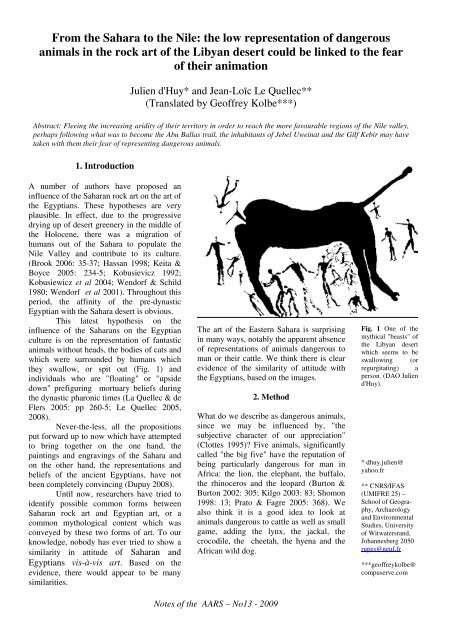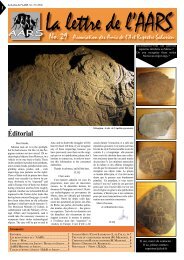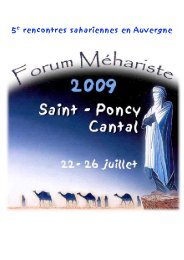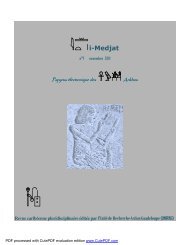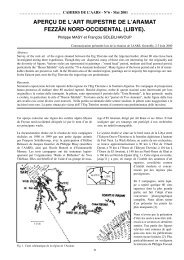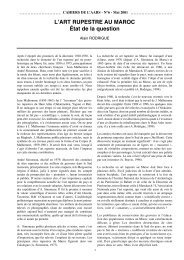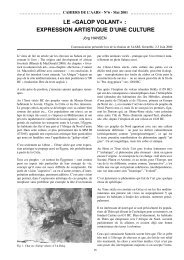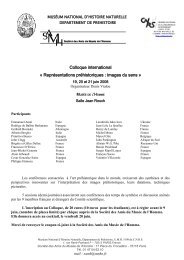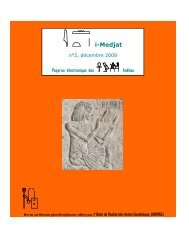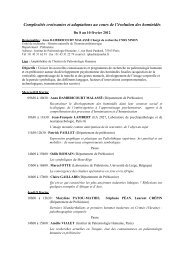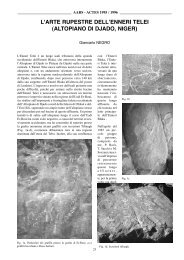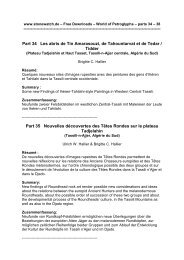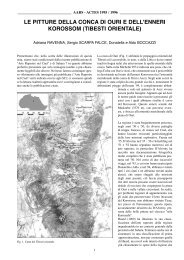From the Sahara to the Nile - Amis de l'Art rupestre saharien (AARS)
From the Sahara to the Nile - Amis de l'Art rupestre saharien (AARS)
From the Sahara to the Nile - Amis de l'Art rupestre saharien (AARS)
You also want an ePaper? Increase the reach of your titles
YUMPU automatically turns print PDFs into web optimized ePapers that Google loves.
<strong>From</strong> <strong>the</strong> <strong>Sahara</strong> <strong>to</strong> <strong>the</strong> <strong>Nile</strong>: <strong>the</strong> low representation of dangerous<br />
animals in <strong>the</strong> rock art of <strong>the</strong> Libyan <strong>de</strong>sert could be linked <strong>to</strong> <strong>the</strong> fear<br />
of <strong>the</strong>ir animation<br />
Julien d'Huy* and Jean-Loïc Le Quellec**<br />
(Translated by Geoffrey Kolbe***)<br />
Abstract: Fleeing <strong>the</strong> increasing aridity of <strong>the</strong>ir terri<strong>to</strong>ry in or<strong>de</strong>r <strong>to</strong> reach <strong>the</strong> more favourable regions of <strong>the</strong> <strong>Nile</strong> valley,<br />
perhaps following what was <strong>to</strong> become <strong>the</strong> Abu Ballas trail, <strong>the</strong> inhabitants of Jebel Uweinat and <strong>the</strong> Gilf Kebir may have<br />
taken with <strong>the</strong>m <strong>the</strong>ir fear of representing dangerous animals.<br />
1. Introduction<br />
A number of authors have proposed an<br />
influence of <strong>the</strong> <strong>Sahara</strong>n rock art on <strong>the</strong> art of<br />
<strong>the</strong> Egyptians. These hypo<strong>the</strong>ses are very<br />
plausible. In effect, due <strong>to</strong> <strong>the</strong> progressive<br />
drying up of <strong>de</strong>sert greenery in <strong>the</strong> middle of<br />
<strong>the</strong> Holocene, <strong>the</strong>re was a migration of<br />
humans out of <strong>the</strong> <strong>Sahara</strong> <strong>to</strong> populate <strong>the</strong><br />
<strong>Nile</strong> Valley and contribute <strong>to</strong> its culture.<br />
(Brook 2006: 35-37; Hassan 1998; Keita &<br />
Boyce 2005: 234-5; Kobusievicz 1992;<br />
Kobusiewicz et al 2004; Wendorf & Schild<br />
1980; Wendorf et al 2001). Throughout this<br />
period, <strong>the</strong> affinity of <strong>the</strong> pre-dynastic<br />
Egyptian with <strong>the</strong> <strong>Sahara</strong> <strong>de</strong>sert is obvious.<br />
This latest hypo<strong>the</strong>sis on <strong>the</strong><br />
influence of <strong>the</strong> <strong>Sahara</strong>ns on <strong>the</strong> Egyptian<br />
culture is on <strong>the</strong> representation of fantastic<br />
animals without heads, <strong>the</strong> bodies of cats and<br />
which were surroun<strong>de</strong>d by humans which<br />
<strong>the</strong>y swallow, or spit out (Fig. 1) and<br />
individuals who are "floating" or "upsi<strong>de</strong><br />
down" prefiguring mortuary beliefs during<br />
<strong>the</strong> dynastic pharonic times (La Quellec & <strong>de</strong><br />
Flers 2005: pp 260-5; Le Quellec 2005,<br />
2008).<br />
Never-<strong>the</strong>-less, all <strong>the</strong> propositions<br />
put forward up <strong>to</strong> now which have attempted<br />
<strong>to</strong> bring <strong>to</strong>ge<strong>the</strong>r on <strong>the</strong> one hand, <strong>the</strong><br />
paintings and engravings of <strong>the</strong> <strong>Sahara</strong> and<br />
on <strong>the</strong> o<strong>the</strong>r hand, <strong>the</strong> representations and<br />
beliefs of <strong>the</strong> ancient Egyptians, have not<br />
been completely convincing (Dupuy 2008).<br />
Until now, researchers have tried <strong>to</strong><br />
i<strong>de</strong>ntify possible common forms between<br />
<strong>Sahara</strong>n rock art and Egyptian art, or a<br />
common mythological content which was<br />
conveyed by <strong>the</strong>se two forms of art. To our<br />
knowledge, nobody has ever tried <strong>to</strong> show a<br />
similarity in attitu<strong>de</strong> of <strong>Sahara</strong>n and<br />
Egyptians vis-à-vis art. Based on <strong>the</strong><br />
evi<strong>de</strong>nce, <strong>the</strong>re would appear <strong>to</strong> be many<br />
similarities.<br />
The art of <strong>the</strong> Eastern <strong>Sahara</strong> is surprising<br />
in many ways, notably <strong>the</strong> apparent absence<br />
of representations of animals dangerous <strong>to</strong><br />
man or <strong>the</strong>ir cattle. We think <strong>the</strong>re is clear<br />
evi<strong>de</strong>nce of <strong>the</strong> similarity of attitu<strong>de</strong> with<br />
<strong>the</strong> Egyptians, based on <strong>the</strong> images.<br />
2. Method<br />
What do we <strong>de</strong>scribe as dangerous animals,<br />
since we may be influenced by, "<strong>the</strong><br />
subjective character of our appreciation"<br />
(Clottes 1995)? Five animals, significantly<br />
called "<strong>the</strong> big five" have <strong>the</strong> reputation of<br />
being particularly dangerous for man in<br />
Africa: <strong>the</strong> lion, <strong>the</strong> elephant, <strong>the</strong> buffalo,<br />
<strong>the</strong> rhinoceros and <strong>the</strong> leopard (Bur<strong>to</strong>n &<br />
Bur<strong>to</strong>n 2002: 305; Kilgo 2003: 83; Shomon<br />
1998: 13; Pra<strong>to</strong> & Fagre 2005: 368). We<br />
also think it is a good i<strong>de</strong>a <strong>to</strong> look at<br />
animals dangerous <strong>to</strong> cattle as well as small<br />
game, adding <strong>the</strong> lynx, <strong>the</strong> jackal, <strong>the</strong><br />
crocodile, <strong>the</strong> cheetah, <strong>the</strong> hyena and <strong>the</strong><br />
African wild dog.<br />
Notes of <strong>the</strong> <strong>AARS</strong> – No13 - 2009<br />
Fig. 1 One of <strong>the</strong><br />
mythical "beasts" of<br />
<strong>the</strong> Libyan <strong>de</strong>sert<br />
which seems <strong>to</strong> be<br />
swallowing (or<br />
regurgitating) a<br />
person. (DAO Julien<br />
d'Huy).<br />
* dhuy.julien@<br />
yahoo.fr<br />
** CNRS/IFAS<br />
(UMIFRE 25) –<br />
School of Geogra-<br />
phy, Archaeology<br />
and Environmental<br />
Studies, University<br />
of Witwatersrand,<br />
Johannesberg 2050<br />
rupes@neuf.fr<br />
***geoffreykolbe@<br />
compuserve.com
For a valid hypo<strong>the</strong>sis, we should not inclu<strong>de</strong><br />
dangerous animals that were not present during <strong>the</strong><br />
period that <strong>the</strong> artists lived in <strong>the</strong> Eastern <strong>Sahara</strong> and,<br />
having done a careful survey of <strong>the</strong> relevant literature,<br />
<strong>the</strong>y are not on our list.<br />
The principal scientific criterion for a<br />
hypo<strong>the</strong>sis is <strong>the</strong> ability <strong>to</strong> be submitted <strong>to</strong> a test and<br />
be refuted by experiment. (Popper 1985). For example,<br />
it is easily refutable if we discover a significant<br />
number of representations of dangerous animals in <strong>the</strong><br />
Libyan <strong>de</strong>sert, or if we show <strong>the</strong> effective absence of<br />
cats, hyenas, wild dogs, elephants and crocodiles in<br />
this part of <strong>the</strong> <strong>de</strong>sert during <strong>the</strong> period of concern.<br />
3.1. Cats<br />
3. Results<br />
Do we find evi<strong>de</strong>nce of cats in <strong>the</strong> Libyan <strong>de</strong>sert<br />
during <strong>the</strong> period of <strong>the</strong> artists? How were <strong>the</strong>y<br />
<strong>de</strong>picted by <strong>the</strong> artists?<br />
The lynx (Caracal caracal, Schreber 1776)<br />
At Djera, <strong>the</strong> remains of <strong>the</strong> wildlife found <strong>the</strong>re echo<br />
<strong>the</strong> rock art images at <strong>the</strong> site: antelopes, gazelles and<br />
ostriches. But although <strong>the</strong> lynx is present in <strong>the</strong> fauna<br />
record, it is not seen on <strong>the</strong> walls of <strong>the</strong> cave. (Gehlen,<br />
Kin<strong>de</strong>rman, Linstä<strong>de</strong>r & Riemer 2004).<br />
The period of <strong>the</strong> artistic work at Djera is not<br />
known with precision, but it must date before 5400 BC<br />
when <strong>the</strong> region was <strong>de</strong>finitely abandoned. The<br />
material of two sites near <strong>the</strong> entrances <strong>to</strong> <strong>the</strong> cave<br />
date from about 5680 <strong>to</strong> 5400 BC (Kuper 1996). Also,<br />
<strong>the</strong> presence of <strong>the</strong> lynx is confirmed elsewhere in <strong>the</strong><br />
Libyan <strong>de</strong>sert during this period (see notably Wendorf<br />
& Schild 2001: 620-1).<br />
To our knowledge, <strong>de</strong>spite this presence, <strong>the</strong>re<br />
is no representation of <strong>the</strong> lynx in <strong>the</strong> rock art. At <strong>the</strong><br />
core of our hypo<strong>the</strong>sis, this absence of "<strong>the</strong> most<br />
ferocious small cat in Africa" (Al<strong>de</strong>n et al 2001: 552)<br />
is hard <strong>to</strong> explain as it predates so successfully on<br />
small game, notably antelope (Sunquist & Sunquist<br />
2002: 40-1).<br />
We would point out that <strong>the</strong> lynx will take domestic<br />
animals just as easily.<br />
The cheetah (Acinonyx jubatus, Scheber 1776)<br />
Of note is <strong>the</strong> absence of any representation of <strong>the</strong><br />
cheetah. Actually, <strong>the</strong> presence of cheetah during <strong>the</strong><br />
epoch of <strong>the</strong> artists is yet <strong>to</strong> be proven as <strong>the</strong> fossil<br />
remains of this animal have yet <strong>to</strong> be discovered in<br />
Egypt (Osborn & Osbornová 1998: 122). Yet,<br />
cheetah are able <strong>to</strong> cope with aridity (Hamdine et<br />
al 2003; Marker 1998).<br />
Almasy ma<strong>de</strong> <strong>the</strong> same observation at Wadi Howar.<br />
Hoogstraal et al (1996-1996) imply that <strong>the</strong> species<br />
may be extinct in Egypt <strong>to</strong>day, but <strong>the</strong>y have been<br />
observed in many places in <strong>the</strong> Nor<strong>the</strong>rn Libyan<br />
<strong>de</strong>sert prior <strong>to</strong> 1990 and <strong>the</strong>re were a number of<br />
cheetahs seen between 1950 and 1960 in <strong>the</strong><br />
Nor<strong>the</strong>rn part of <strong>the</strong> Egypt-Libya frontier.<br />
It is <strong>the</strong> extermination of <strong>the</strong> gazelle – <strong>the</strong>ir<br />
favourite prey – in recent times that has led <strong>to</strong> <strong>the</strong><br />
gradual disappearance of <strong>the</strong> cheetah in <strong>the</strong>se<br />
marginal habitats.<br />
The question that remains <strong>to</strong> be answered<br />
is: were <strong>the</strong>y present, and not painted, or were <strong>the</strong>y<br />
actually absent?<br />
In <strong>the</strong> shelter of Saddle Talh at Jebel<br />
Uweinat, one representation displays an animal<br />
attacking a cow. Some investiga<strong>to</strong>rs propose that<br />
<strong>the</strong> animal is a cheetah or a savage cat (Böckli &<br />
Marai 2008: 145). The i<strong>de</strong>ntification of this<br />
representation is very doubtful without fur<strong>the</strong>r<br />
evi<strong>de</strong>nce of <strong>the</strong> cheetah's presence in <strong>the</strong> Libyan<br />
<strong>Sahara</strong> during <strong>the</strong> period <strong>the</strong> paintings were ma<strong>de</strong>.<br />
This should be treated with a good <strong>de</strong>al of<br />
circumspection.<br />
The leopard (Pan<strong>the</strong>ra pardus, Linnaeus 1758)<br />
Are <strong>the</strong>re any leopards in <strong>the</strong> Eastern <strong>de</strong>sert? To our<br />
knowledge, this has not been proven. This species is<br />
known in <strong>the</strong> upper Palaeolithic, and <strong>the</strong> predynastic<br />
Eastern <strong>de</strong>sert from 7000 <strong>to</strong> 3000 BC<br />
(Goodman et al 1992).<br />
A mistaken claim of a discovery was ma<strong>de</strong><br />
in a limes<strong>to</strong>ne shelter on <strong>the</strong> Plateau of Galala,<br />
where <strong>the</strong>re was a picture which supposedly showed<br />
a group of leopards being chased by several men<br />
armed with spears (Hobbs & Goodman 1995). It is<br />
uncertain if <strong>the</strong> paintings, possibly dating from<br />
3957 <strong>to</strong> 3500 BC, represent leopards (Midant-<br />
Reynes & Muzzolini 1995). But <strong>the</strong> remains of this<br />
species which have been excavated in this area date<br />
from 9570 <strong>to</strong> 2276 BP and so confirm <strong>the</strong> presence<br />
of leopard in this region. This is not surprising from<br />
an animal that can <strong>to</strong>lerate a certain aridity (Al-<br />
Johany 2007: 26-7). But we note that no trace in <strong>the</strong><br />
archaeological record has been found (yet) in <strong>the</strong><br />
<strong>de</strong>sert West of <strong>the</strong> <strong>Nile</strong>.
So if this species was present in nature, <strong>the</strong><br />
absence of any representation of it in <strong>the</strong> rock art<br />
possibly comes from a fear of predation from this<br />
cat on small game, cattle, and on man.<br />
The lion (Pan<strong>the</strong>ra leo, Linnaeus 1758)<br />
Three lions, being stalked by two<br />
archers, have been discovered in <strong>the</strong> famous<br />
Cave of Swimmers in Wadi Sora (Le Quellec &<br />
<strong>de</strong> Flers 2005: 216; Le Quellec 2006: 59).<br />
In one scene we see two archers, <strong>the</strong>ir<br />
bows drawn and pointed in <strong>the</strong> direction of a cat<br />
painted in a flat white, which seems <strong>to</strong> threaten<br />
<strong>the</strong>ir colleagues (Fig. 2). It could be a lion or a<br />
leopard, both are equally dangerous <strong>to</strong> man. And<br />
yet, amongst <strong>the</strong> dangerous cats, <strong>the</strong> leopard will<br />
often (but not always) ambush by swooping<br />
down from a tree, whereas a lion uniquely will<br />
charge out of <strong>the</strong> sun. Too, <strong>the</strong> coat of <strong>the</strong> animal<br />
<strong>de</strong>picted has no markings, so we tend <strong>to</strong> think<br />
that <strong>the</strong> animal is a lion.<br />
The use of white paint in this<br />
representation is a typical characteristic of <strong>the</strong><br />
later painters at Wadi Sora (Le Quellec & <strong>de</strong><br />
Flers 2005: 287), and is a sign that <strong>the</strong> population<br />
of lions survived for a relatively long time in that<br />
region. However, it is a mistake <strong>to</strong> think that if an<br />
animal is rarely represented in <strong>the</strong> rock art <strong>the</strong>n<br />
this must be due <strong>to</strong> aridification of <strong>the</strong> <strong>Sahara</strong>.<br />
Possibly, we should not be surprised at <strong>the</strong><br />
presence of lions in <strong>the</strong> <strong>de</strong>sert. These animals are<br />
capable of not drinking for many days where<br />
water is rare or unavailable and can survive on<br />
<strong>the</strong> liquid content of <strong>the</strong>ir prey (Sunquist &<br />
Sunquist 2002: 289). There have been kills seen<br />
in remote regions of Somalia without any<br />
watering holes and where <strong>the</strong> nearest water is 50<br />
kilometres away (Herman et al 1994: 16). What<br />
is more, <strong>the</strong>y still survived at <strong>the</strong> limit of Aïr and<br />
Adrar <strong>de</strong>s Iforas at <strong>the</strong> start of <strong>the</strong> last century<br />
(Gauthier et al 1996: 58) and Michael Mason<br />
(1935) tells of his discovery of an abandoned lion<br />
<strong>de</strong>n in <strong>the</strong> arid Wadi Howar region of Sudan. The<br />
fossil remains of this species are rare in Egypt<br />
and are limited <strong>to</strong> two bones found by Von <strong>de</strong><br />
Driesch and Boesneck (see in Osborn, Dale J. &<br />
Osbornová 1998: 114).<br />
The question of representation of lions in<br />
Egypt is complex, because certain pre-dynastic<br />
and First Dynasty figures show Mesopotamian<br />
styles which influence <strong>the</strong>ir interpretation of <strong>the</strong><br />
natural environment. Notable are <strong>the</strong> ornate lions<br />
on <strong>the</strong> ivory sceptre from Herakleopolis (Quibell<br />
1900, I pl. XIX-6), and <strong>the</strong> ones on <strong>the</strong> famous<br />
knife handles from Jebel el-Arak and also Jebel<br />
el-Tarif (Hemmer 1963).<br />
And yet, with its superb adaptation<br />
between <strong>the</strong> two extremes, <strong>the</strong><br />
population of lions was maintained<br />
in <strong>the</strong> <strong>Sahara</strong> region throughout<br />
antiquity.<br />
The magical grave s<strong>to</strong>nes of<br />
<strong>the</strong> First Age show Horus controlling<br />
a lion and oryx, and <strong>the</strong> god Shed<br />
who, mounted on a chariot, tramples<br />
crocodiles and hunts animals in <strong>the</strong><br />
<strong>de</strong>sert: snakes, scorpions, lions and<br />
oryx (Brunner-Traut 1997;<br />
Quaegebeur 1999, Fig 47a &b).<br />
Their capacity <strong>to</strong> adapt and<br />
<strong>the</strong> persistence of a population in <strong>the</strong><br />
Egyptian <strong>de</strong>sert throughout antiquity<br />
refutes <strong>the</strong> i<strong>de</strong>a of <strong>the</strong> rarity of lions<br />
as a cause of <strong>the</strong>ir poor<br />
representation. And so, it is shown<br />
that equating <strong>the</strong> poor representation<br />
of this species <strong>to</strong> its population<br />
<strong>de</strong>nsity is of little value. As game is<br />
less plentiful in <strong>the</strong> <strong>de</strong>sert, each pri<strong>de</strong><br />
of lions would need a large exten<strong>de</strong>d<br />
area. It would be wrong <strong>to</strong> say that<br />
<strong>the</strong> animal was poorly represented as<br />
a consequence of it being less<br />
common. The usual prey of lions are<br />
<strong>the</strong> large and medium sized<br />
ungulates. It has been calculated that<br />
one lion gets through from ten <strong>to</strong><br />
about sixty animals of prey each year<br />
(Sunquist & Sunquist 2002: 202). A<br />
small pri<strong>de</strong>, with about six or seven<br />
lions of different ages, hunts about<br />
twice a week (La Faune 10: 192).<br />
An average pri<strong>de</strong> can get through<br />
more than a hundred ungulates a<br />
year, <strong>to</strong> give some i<strong>de</strong>a<br />
Fig. 2 Detail from <strong>the</strong><br />
paintings in <strong>the</strong> Cave<br />
of Beasts. At <strong>the</strong> <strong>to</strong>p,<br />
two people in dark<br />
colouring appear <strong>to</strong><br />
bend <strong>the</strong>ir bows<br />
(white) in <strong>the</strong><br />
direction of a cat (in<br />
uniform white) which<br />
seems <strong>to</strong> be<br />
threatening <strong>the</strong>ir<br />
friends.
Fig. 3 The<br />
pawprints of a<br />
cat in <strong>the</strong> cave<br />
of Obeydh.<br />
of how much terri<strong>to</strong>ry is required <strong>to</strong> support<br />
<strong>the</strong>m. But if <strong>the</strong>ir terri<strong>to</strong>ry in certain areas of<br />
<strong>the</strong> Serengeti is about 260 km 2 , this is not<br />
sufficient <strong>to</strong> justify <strong>the</strong> small number of <strong>the</strong>ir<br />
representations. How do we explain why<br />
<strong>the</strong>y appear with great regularity in <strong>the</strong><br />
ancient Egyptian <strong>Nile</strong> valley and <strong>the</strong>y are<br />
given such mythological importance<br />
(Schweitzer 1948).<br />
The small number of images can be<br />
explained by how dangerous <strong>the</strong> lion was for<br />
man. Also, significantly, in <strong>the</strong> rare<br />
representations of cats in <strong>the</strong> Libyan <strong>de</strong>sert,<br />
<strong>the</strong> animals present a threat <strong>to</strong> <strong>the</strong> archer.<br />
Much later, <strong>the</strong> species continued <strong>to</strong><br />
survive but was hardly more represented,<br />
<strong>the</strong>re is little <strong>to</strong> add <strong>to</strong> <strong>the</strong> reason <strong>the</strong>y<br />
refused <strong>to</strong> hunt cats in a group. Elsewhere in<br />
<strong>the</strong> <strong>Sahara</strong>, in engravings from <strong>the</strong> period<br />
when camels first appeared, lions are seen <strong>to</strong><br />
take domestic cows (Gauthier et al 1996:<br />
58).<br />
The "Beasts" of Wadi Sora<br />
There are a little over thirty representations<br />
of "beasts" of <strong>the</strong> same type as discovered in<br />
Wadi Sora. Morelli et al (2006) <strong>de</strong>scribed<br />
<strong>the</strong>m as "ancephalic lions". These beasts are<br />
apparently dangerous, mythological<br />
creatures which, for sure, are shown in <strong>the</strong><br />
act of swallowing humans.<br />
They show one characteristic feature<br />
which most critics are reasonably content <strong>to</strong><br />
accept. "On <strong>the</strong> beasts, in place of a head,<br />
<strong>the</strong>re is a curious cleft between two humps<br />
of unequal size which do not correspond<br />
with <strong>the</strong> ana<strong>to</strong>my of any known quadruped."<br />
(Le Quellec 2005: 7d1). As we come <strong>to</strong> later<br />
on, it is possible that this is a very significant<br />
<strong>de</strong>tail.<br />
The pawprints of cats in <strong>the</strong> cave of el-Obeydh<br />
The shelter of Wadi el-Obeydh has a series of cat<br />
pawprints carved in<strong>to</strong> <strong>the</strong> wall, ma<strong>de</strong> between <strong>the</strong><br />
6 th and 4 th millennium before present (Barich<br />
1998). The majority of <strong>the</strong>se imprints show more<br />
that four digits, which is <strong>the</strong> number normally<br />
seen in cats in nature. (Fig. 3). We <strong>the</strong>refore<br />
think that <strong>the</strong>se sacred engravings represent <strong>the</strong><br />
passage of a cat which is without doubt mythical<br />
and not natural. Too, we think that <strong>the</strong> pawprints<br />
are not a <strong>to</strong>ken representation of <strong>the</strong> animal itself,<br />
but assume a synecdochical function, in which a<br />
part stands for <strong>the</strong> whole and permits <strong>the</strong><br />
presence of a dangerous animal <strong>to</strong> be signified<br />
without taking <strong>the</strong> risk of representing it in its<br />
entirety. If this is <strong>the</strong> case, <strong>the</strong> engravings of<br />
<strong>the</strong>se supernatural pawprints are closer <strong>to</strong> <strong>the</strong><br />
"headless beasts" of Wadi Sora (Le Quellec & <strong>de</strong><br />
Flers 2005: 49-50).<br />
The uni<strong>de</strong>ntified cats<br />
In Jebel Uweinat, on <strong>the</strong> slopes of Wadi Wahass,<br />
we noted two giraffes pursued by a cat (Le<br />
Quellec & <strong>de</strong> Flers 2005: 80). In <strong>the</strong> same<br />
mountain, two scenes (Figs. 4 and 6) and<br />
probably a third (Fig. 5) show a group of archers<br />
attacking animals which resemble cats. These<br />
scenes date from <strong>the</strong> pas<strong>to</strong>ral period of <strong>the</strong> region<br />
and show that <strong>the</strong> cowherds of Jebel Uweinat<br />
used <strong>the</strong>ir bows <strong>to</strong> <strong>de</strong>fend <strong>the</strong>ir herd against<br />
attacks from cats. These tawny beings were<br />
<strong>the</strong>refore present in <strong>the</strong> mountains at <strong>the</strong> same<br />
time as <strong>the</strong> archers. What <strong>the</strong>se ancient hunts<br />
show is that <strong>the</strong> cats were without sufficient<br />
numbers <strong>to</strong> exercise significant pressure on <strong>the</strong><br />
herds. And yet, <strong>the</strong> cats are represented in small<br />
numbers which contrasts greatly with <strong>the</strong><br />
quantity of engravings <strong>to</strong> be seen in Tassili n-<br />
Azjer, Tibesti and <strong>the</strong> Fezzan.
3.2. The Hyena<br />
The striped hyena (Hyaena hyaena, Linnaeus<br />
1758)<br />
The remains of <strong>the</strong> striped hyena, dating from<br />
4800 – 3750 BC have been found in <strong>the</strong> Libyan<br />
<strong>de</strong>sert (Peters 1988: 75). The presence of this<br />
animal during <strong>the</strong> period of <strong>the</strong> engravers has been<br />
confirmed <strong>to</strong> <strong>the</strong> North East of a line from Siwa <strong>to</strong><br />
Abu Simbel (Wendorf & Schild 2001: 620),<br />
without <strong>the</strong>re being any representation in <strong>the</strong> rock<br />
art <strong>to</strong> our knowledge. The striped hyena<br />
occasionally attacks cattle (Kruuk 2005:86; Mills<br />
& Hofer 1998: 23-4), and human beings, notably<br />
children (Mills & Hofer 1998: 87; Nowak et al<br />
2005: 226). These are dangerous animals.<br />
3.3. The dogs<br />
The African Wild Dog (Lycaon pictus,<br />
Temminck 1820)<br />
The African Wild Dog which subsists in <strong>the</strong><br />
central <strong>Sahara</strong> (Bur<strong>to</strong>n & Bur<strong>to</strong>n 1973: 2752; Le<br />
Quellec 1998: 352), probably co-existed with <strong>the</strong><br />
artists of <strong>the</strong> Libyan <strong>de</strong>sert. Mason and Szechenyi<br />
have indicated <strong>the</strong>ir presence in Wadi Howar.<br />
They also had a wi<strong>de</strong>spread presence in Egypt.<br />
But elsewhere, according <strong>to</strong> <strong>the</strong> archaeozoologist<br />
Achille Gautier, <strong>the</strong> absence of a species which<br />
was not normally part of <strong>the</strong> prehis<strong>to</strong>ric diet is<br />
hardly surprising (1993: 262-4). The apparent<br />
ferocity of this animal, which <strong>the</strong>se days does not<br />
attack man, perhaps explains why it is not<br />
represented: "The spectacle of a pack of wild dogs<br />
tearing at a live animal still on its feet is dreadful<br />
and without doubt one of <strong>the</strong> most impressive<br />
sights on <strong>the</strong> plains of Africa. And when we are on<br />
hand at a tragedy of this sort, we<br />
would not be greatly surprised if<br />
<strong>the</strong>se carnivores are consi<strong>de</strong>red<br />
<strong>the</strong> most cruel" (La Faune 13:<br />
250).<br />
But elsewhere, <strong>the</strong> East<br />
Africans have an eloquent saying<br />
about <strong>the</strong> dog which is, "<strong>the</strong><br />
running <strong>de</strong>ath on <strong>the</strong> plains" (Le<br />
Quellec 1998: 356). The wild<br />
dog is strong enough <strong>to</strong> take on<br />
<strong>the</strong> very large antelopes, also<br />
giraffes and even lions, in<br />
isolation (Bur<strong>to</strong>n & Bur<strong>to</strong>n<br />
1973: 2752). The end is so<br />
dreadful that <strong>the</strong>y are feared as<br />
much as large cats, such as <strong>the</strong><br />
pan<strong>the</strong>r (Le Quellec 1998: 357).<br />
It is this terrible ferocity<br />
which makes <strong>the</strong>m appear such a<br />
menace <strong>to</strong> <strong>the</strong> inhabitants of <strong>the</strong><br />
<strong>de</strong>sert. One engraving in Wadi<br />
Fig. 4. A painting from<br />
Karkur Talh (Jebel<br />
Uweinat) shows a group<br />
of archers, with arrows in<br />
abundance hanging from<br />
a cat (in flat white).<br />
O<strong>the</strong>r people are running<br />
<strong>to</strong> <strong>the</strong> right away from<br />
<strong>the</strong> group. One of <strong>the</strong><br />
cows is turning its head<br />
<strong>to</strong>wards <strong>the</strong> dying cat,<br />
recognisable from its<br />
long,<br />
erect tail (pho<strong>to</strong> JLLQ).<br />
Fig 5. O<strong>the</strong>r paintings in<br />
Karkur Talh are difficult<br />
<strong>to</strong> make out. But we can<br />
recognise an archer<br />
bending his bow <strong>to</strong>wards<br />
two cats with missing<br />
heads, which are<br />
reminiscent of <strong>the</strong><br />
mythical "beast" in Fig. 1<br />
(pho<strong>to</strong> JLLQ).
Fig.6. Ano<strong>the</strong>r<br />
painting in<br />
Karkur Talh<br />
showing a cat in<br />
a uniform glossy<br />
white without its<br />
head, which is<br />
shot in <strong>the</strong><br />
presence of cows<br />
and an elongated<br />
enigmatic form<br />
(pho<strong>to</strong> JLLQ).<br />
Imrawen, in <strong>the</strong> Libyan Messak, showed<br />
how a wild dog leapt at <strong>the</strong> throat of one<br />
person (Le Quellec 2004: 31; 1998 362-4).<br />
It is also possible <strong>to</strong> see in several valleys<br />
of <strong>the</strong> Messak, engravings showing packs<br />
of dogs – without doubt African Wild Dogs<br />
– assailing herbivores and sometimes men<br />
(Gauthier et al 1996: 59).<br />
The absence of representations of<br />
<strong>the</strong>se dogs, able <strong>to</strong> exercise such strong<br />
predation on cattle (Kruuk 2005: 86;<br />
Woodroffe et al 2005), shows how<br />
dangerous <strong>the</strong>y were.<br />
The Jackal (Canis aureus, Linnaeus 1758)<br />
The Jackal is at home in <strong>the</strong> <strong>de</strong>sert and is<br />
actually found in <strong>the</strong> Western <strong>Sahara</strong>. In<br />
consequence, it would clearly be surprising<br />
if <strong>the</strong>y were absent from this region during<br />
<strong>the</strong> epoch of <strong>the</strong> engravers. Fossil remains<br />
have been discovered at <strong>the</strong> Neolithic level<br />
at Bir Tarfawi, Hakhla, esh-Shaheinab,<br />
Saggai and Merim<strong>de</strong>-Beni-Salama<br />
(Gransard-Desmond 2004: tabl. 3). And<br />
yet, none figure in <strong>the</strong> rock art of Egypt<br />
with any certainty (Osborn & Osbornová<br />
1998: 56).<br />
While this animal may show a<br />
preda<strong>to</strong>ry behaviour <strong>to</strong>wards <strong>the</strong> herd<br />
(Yom-Tov 1995) <strong>the</strong>re is no authoritative<br />
zoological criterion which can be i<strong>de</strong>ntified<br />
with any certainty in any artistic<br />
representation (Gransard-Desmond 2004:<br />
44), but its absence in <strong>the</strong> bestiary is also<br />
explained by a universal reaction of man<br />
facing carnivores which is inherited from<br />
our evolution. In effect, it is an instinctive<br />
reaction <strong>to</strong> <strong>the</strong> great strength and killing<br />
ability of large preda<strong>to</strong>rs, such as <strong>the</strong> lion,<br />
<strong>the</strong> leopard and <strong>the</strong> wild dog. Also for <strong>the</strong><br />
many lesser preda<strong>to</strong>rs which do not have<br />
imposing fangs and claws, such as <strong>the</strong><br />
jackal, <strong>the</strong> reaction is <strong>the</strong> same – although a<br />
little less (Kruuk 2005; 166-7).<br />
This could explain <strong>the</strong> equivalence in <strong>the</strong><br />
way small and large carnivores were<br />
treated in <strong>the</strong> rock art of <strong>the</strong> Libyan<br />
<strong>de</strong>sert. It could also explain <strong>the</strong> absence<br />
of <strong>the</strong> Fennec fox in <strong>the</strong> iconography of<br />
prehis<strong>to</strong>ric Egypt, although <strong>the</strong>re is little<br />
evi<strong>de</strong>nce of it in <strong>the</strong> fauna record<br />
(Gransard-Desmond 2004: 40). An<br />
animal such as <strong>the</strong> jackal which in reality<br />
is somewhat timid, non-<strong>the</strong>-less inspired<br />
a powerful myth for <strong>the</strong> ancient<br />
Egyptians. Isheb, a kind of <strong>de</strong>ep red<br />
jackal with a long tail, reputedly came<br />
in<strong>to</strong> barns at night <strong>to</strong> <strong>de</strong>vour animals,<br />
starting with <strong>the</strong> largest (Vernus &<br />
Yoyotte 2005:167). Also, in Libya in <strong>the</strong><br />
1960s, a lynx attacked sheep with such<br />
cunning that shepherds thought it was<br />
some sort of monstrous jackal, capable<br />
of avoiding <strong>the</strong>ir dogs and remaining<br />
elusive (Hufnagl 1972: 42).<br />
This unique reaction, caused by<br />
<strong>the</strong> sight of a majority of carnivores, is<br />
strongly reflected in Egyptian<br />
mythology. The gods who are<br />
represented by large carnivores are<br />
generally very dangerous. Pakhet, <strong>the</strong><br />
lion-god<strong>de</strong>ss is <strong>the</strong> "Ripper", legendary<br />
for <strong>the</strong> ferocity which which it met <strong>the</strong><br />
enemies of Egypt (Bunson 2002: 294).<br />
The lion-god Mahes is also a <strong>de</strong>vourer of<br />
<strong>the</strong> enemies of Egypt (Bunson 2002:<br />
221). Mati, and <strong>the</strong> feminine form Matit,<br />
are lion divinities with a war-like<br />
function (Borghout 1978: 112, n. 328).<br />
Maf<strong>de</strong>t, a god<strong>de</strong>ss in <strong>the</strong> form of a<br />
lioness mentioned in <strong>the</strong> Pyramid Texts<br />
as a "killer of serpents", possibly<br />
protected and avenged <strong>the</strong> pharaoh. She<br />
embodied a judicial authority and it is<br />
thought was originally represented by a<br />
leopard (Wilkinson 2005: 249-51).<br />
Sekhmet "<strong>the</strong> powerful", ano<strong>the</strong>r liongod<strong>de</strong>ss,<br />
ruled over wars and disasters.<br />
Hathor, daughter of <strong>the</strong> god Re, changed
in<strong>to</strong> a lioness for her secret mission <strong>to</strong> exterminate<br />
<strong>the</strong> human race and in this form was i<strong>de</strong>ntified as<br />
Sekhmet (Shaw & Nicholson 2002: 257). Mekhit,<br />
leonine consort <strong>to</strong> Onuris, was one of <strong>the</strong> divinities<br />
that appeared as <strong>the</strong> vengeful eye of Re, like Mestjet,<br />
<strong>the</strong> god<strong>de</strong>ss with <strong>the</strong> head of a lion (Wilkinson 2003:<br />
179). The god<strong>de</strong>ss Meresger, charged with punishing<br />
wrongdoers by eating <strong>the</strong>m, is <strong>de</strong>scribed as a "savage<br />
lion" (Bunson 2002: 239). The iconography of Tutu,<br />
"<strong>the</strong> one who hunts <strong>the</strong> enemies", shows him as a<br />
walking lion and as a sphinx who has a human head<br />
and <strong>the</strong> body of a lion (Kaper 2003: 35). Although he<br />
was later consi<strong>de</strong>red quite benign, Shezmu was best<br />
known for his cruelty and was also represented as a<br />
lion or a man with <strong>the</strong> head of a lion.<br />
Their dangerous nature predisposed <strong>the</strong> liongods<br />
<strong>to</strong> become effective guardians. So it was that<br />
Akeru, a pair of lion-gods, were guardians of <strong>the</strong><br />
horizon and protec<strong>to</strong>rs of <strong>the</strong> solar-boat on its<br />
celestial voyage (Bunson 2002: 18, 171). Matit, who<br />
has already been mentioned, served as guardian of<br />
royal resi<strong>de</strong>nces (Bunson 2002: 228) and Mehit, also<br />
a lion-god<strong>de</strong>ss, was essentially a protec<strong>to</strong>r. Mahes<br />
"<strong>the</strong> lion", <strong>the</strong> divine warrior already mentioned, also<br />
functioned well as a guardian of sacred areas, and <strong>the</strong><br />
un<strong>de</strong>rworld god Kherty, at once hostile and a<br />
protec<strong>to</strong>r, <strong>to</strong>ok on <strong>the</strong> form of a lion amongst o<strong>the</strong>rs<br />
(Wilkinson 2003: 178).<br />
One magical use of <strong>the</strong> lion's aggressiveness<br />
was in <strong>the</strong> figureheads on <strong>the</strong> prows of Egyptian<br />
navy ships when fighting against <strong>the</strong> Sea People.<br />
They were lion's heads with teeth showing (Shaw<br />
1991: 63-4). This negative vision is exten<strong>de</strong>d <strong>to</strong> <strong>the</strong><br />
small carnivores, such as Anubis, <strong>the</strong> god with <strong>the</strong><br />
head of a jackal, who accompanied <strong>the</strong> <strong>de</strong>ad <strong>to</strong> <strong>the</strong><br />
un<strong>de</strong>rworld (with one o<strong>the</strong>r leonine divinity, Aket,<br />
who was also associated with mortuary rituals).<br />
Only Bastet, a god<strong>de</strong>ss with <strong>the</strong> head of a cat<br />
represented joy and fertility, but we should<br />
remember that un<strong>de</strong>r <strong>the</strong> name of Shesmetet, she<br />
could take <strong>the</strong> form of a lion-god<strong>de</strong>ss (Bunson 2002:<br />
372). It is worth noting a magical ceremony that <strong>to</strong>ok<br />
place during <strong>the</strong> Middle Kingdom period (ca 2040-<br />
1640 BC) <strong>to</strong> "close <strong>the</strong> mouth of lions, hyenas and<br />
all <strong>the</strong> species of animals with erect tails who feed on<br />
flesh" (Borghouts 1978: 50). This magic formula<br />
was actually addressed <strong>to</strong> an assembly of carnivores<br />
– and it is remarkable that <strong>the</strong> "erect tails" which is<br />
mentioned is exactly what we see as a constant<br />
feature in <strong>the</strong> strange ancephales from <strong>the</strong> "cave of<br />
<strong>the</strong> swimmers" and <strong>the</strong> cave of beasts (Fig. 1). In<br />
what is effectively an aquatic world, it should be<br />
noted that Ammit, who, as her name indicates ('mtmwtw'),<br />
<strong>de</strong>voured <strong>de</strong>ad sinners in <strong>the</strong> un<strong>de</strong>rworld, is<br />
a composite, "combining <strong>the</strong> characteristics of<br />
dangerous animals as was typical of <strong>the</strong> ancient<br />
Egyptians" (Wilkinson 2003: 218); a terrestrial<br />
carnivore, <strong>the</strong> lion, and its aquatic equivalent <strong>the</strong><br />
crocodile, and a dangerous amphibian animal <strong>the</strong><br />
hippopotamus. Finally, Zan<strong>de</strong>e notes that <strong>the</strong> lion<br />
is feared above o<strong>the</strong>r animals who eat those<br />
who have lately passed in<strong>to</strong> <strong>the</strong> un<strong>de</strong>rworld<br />
and how <strong>the</strong> "Book of <strong>the</strong> Dead" gives a<br />
spell for protection (Zan<strong>de</strong>e 1960: 195).<br />
3.4. The elephant (Loxodonta<br />
africana)<br />
There are a number of indica<strong>to</strong>rs that attest<br />
<strong>to</strong> <strong>the</strong> presence of <strong>the</strong> elephant in <strong>the</strong><br />
Libyan <strong>de</strong>sert during <strong>the</strong> epoch of <strong>the</strong><br />
artists, or at least <strong>the</strong> beginnings <strong>the</strong>reof.<br />
To <strong>the</strong> South West of a line from<br />
Siwa <strong>to</strong> Abu Simbel, one engraved elephant<br />
is <strong>to</strong> be seen at Jebel Suba, amongst a large<br />
number of giraffes, <strong>to</strong> <strong>the</strong> East of <strong>the</strong> track<br />
from Kufra <strong>to</strong> Uweinat (Berger & Berger<br />
2003: Fig. 2). An elephant is also<br />
represented in <strong>the</strong> Cave of Beasts (Fig. 8).<br />
This representation is one of <strong>the</strong> ol<strong>de</strong>st<br />
locally. One giraffe was nicely engraved on<br />
<strong>the</strong> internal surface and <strong>the</strong> people ad<strong>de</strong>d<br />
over it (Le Quellec & <strong>de</strong> Flers 2005: 287,<br />
326-7). Lastly, we should also note an<br />
elephant amongst <strong>the</strong> many ancient<br />
engravings in a shelter discovered at Wadi<br />
Sora (Morelli et al 2006: 180) and one or<br />
perhaps several o<strong>the</strong>rs at Wadi Hamra<br />
(Zboray 2008: 150).<br />
If we look <strong>to</strong> <strong>the</strong> North East of a<br />
line from Siwa <strong>to</strong> Abu Simbel, we do not<br />
find any elephants.<br />
Certain observers think that <strong>the</strong><br />
representations of elephants are from prior<br />
<strong>to</strong> <strong>the</strong> commencement of rock art (Zboray,<br />
personal communication) – in that case,<br />
have <strong>the</strong> images of <strong>the</strong> elephants survived<br />
<strong>de</strong>spite <strong>the</strong> harshness and aridity of <strong>the</strong><br />
environment? Their non-representation may<br />
result from a choice by <strong>the</strong> artists and not as<br />
a consequence of <strong>the</strong> facts of nature.<br />
Fig. 7. Engraving of an elephant at Jebel Suba (pho<strong>to</strong> JLLQ).
Fig.8. Engraving<br />
of an elephant in<br />
<strong>the</strong> Cave of Beasts<br />
(pho<strong>to</strong> JLLQ).<br />
Fig. 9. A Small<br />
group of<br />
engravings from<br />
<strong>the</strong> Libyan <strong>de</strong>sert<br />
(M20o14-06)<br />
shows two people<br />
being attacked by<br />
crocodiles with a<br />
boat seen close by<br />
(pho<strong>to</strong> F. Berger<br />
cf. Berger 2009<br />
Fig 16).<br />
Very late fossil remains of elephants have been<br />
discovered in <strong>the</strong> Libyan <strong>de</strong>sert, particularly in <strong>the</strong><br />
Calancio Serir. They date from 3420 ± 230 BP for<br />
<strong>the</strong> most ancient, <strong>to</strong> 2385 ± 49 BP for <strong>the</strong> most<br />
mo<strong>de</strong>rn (Gabriel 1977: 51). These traces appear <strong>to</strong><br />
confirm <strong>the</strong> proposal of Lucian, who writes in<br />
Dipsas, <strong>the</strong> Thirst Snake that <strong>the</strong> Garamantians<br />
hunted elephants in <strong>the</strong> <strong>de</strong>sert, where <strong>the</strong><br />
pachy<strong>de</strong>rms were resistant <strong>to</strong> thirst and <strong>the</strong> heat (2;<br />
1968: 76-7). This assertion of <strong>the</strong> ancient his<strong>to</strong>rian<br />
is, however, open <strong>to</strong> question. (Gsell 1913: 80; n.3;<br />
Le Quellec 2004: 46).<br />
Between <strong>the</strong> time when <strong>the</strong> <strong>Sahara</strong>ns<br />
engraved elephants and when we actually find<br />
traces of <strong>the</strong>m, it is consi<strong>de</strong>red that <strong>the</strong>re probably<br />
were pachy<strong>de</strong>rms in Eastern <strong>Sahara</strong>. This<br />
hypo<strong>the</strong>sis is corroborated by <strong>the</strong> biology of <strong>the</strong><br />
species. The limits of population <strong>to</strong>day are between<br />
<strong>the</strong> isohyetal lines of 150mm and 510mm of rain.<br />
Incursions <strong>to</strong> <strong>the</strong> North of <strong>the</strong> lower isohyet show<br />
that <strong>the</strong> elephant can perhaps adapt where <strong>the</strong>re are<br />
seasonal highs in temperature and conditions are<br />
quasi-<strong>de</strong>sert (Huard & Leclant 1980: 27; Le Quellec<br />
1998: 221; 1999: 168, 172; Rodrigue 1999: 64).<br />
For example, until very recently <strong>the</strong>se<br />
animals walked across <strong>the</strong> plateau of El<br />
Aagher in Mauritania, which is<br />
practically <strong>de</strong>sert, where <strong>the</strong>re is some<br />
scarce water in <strong>the</strong> East. The rain only<br />
falls for about three months of <strong>the</strong> year<br />
and <strong>the</strong> vegetation is very scattered (La<br />
Faune 16: 16). The Pachy<strong>de</strong>rms<br />
survive easily in <strong>the</strong> Kaokoveld <strong>de</strong>sert<br />
in Namibia where <strong>the</strong>re is less than<br />
150mm of rain fall per year (Le<br />
Quellec 1998: 204; 1999: 168; Le<br />
Quellec & <strong>de</strong> Flers 2005: 327; Viljoen<br />
1993: 131-3). In <strong>the</strong>se conditions, even<br />
<strong>the</strong> smallest thing would s<strong>to</strong>p a small,<br />
but permanent presence of elephants in<br />
<strong>the</strong> Libyan <strong>de</strong>sert surviving during <strong>the</strong><br />
period of <strong>the</strong> engravers.<br />
The small number of<br />
representations of pachy<strong>de</strong>rms is<br />
probably a consequence of <strong>the</strong> low<br />
<strong>de</strong>nsity of <strong>the</strong> species at <strong>the</strong> time of <strong>the</strong><br />
artists (Le Quellec & <strong>de</strong> Flers 2005:<br />
327), but it could also be explained by<br />
an unwillingness <strong>to</strong> represent a very<br />
dangerous animal, capable of charging<br />
powerfully without any apparent cause<br />
(Bere 1966: 82; Estes 1991: 267). Also,<br />
in West I-n-Djeran, in <strong>the</strong> Algerian<br />
Tadrart, an individual armed with a<br />
curved sword fled <strong>the</strong> wrath of a<br />
pursuing elephant (Gauthier et al 1996:<br />
99). These explanations are, of course,<br />
not <strong>the</strong> only ones.<br />
3.5. The crocodile (Crocodylus nilo-<br />
ticus, Lanrenti 1768)<br />
This animal, which can be up <strong>to</strong> seven<br />
metres long, would have been very<br />
dangerous <strong>to</strong> <strong>the</strong> men of <strong>the</strong> Holocene<br />
and <strong>the</strong>ir cattle. Today in Africa, <strong>the</strong>y<br />
are responsible for a large number of<br />
human <strong>de</strong>aths and attacks on animals,<br />
drawing ahead of <strong>the</strong> hippopotamus.<br />
Every year, many hundreds of people<br />
are <strong>de</strong>voured by <strong>Nile</strong> crocodiles<br />
(Grzimek 2003, VII: 163). This reptile<br />
is on <strong>the</strong> brink of extinction in Egypt,<br />
but since <strong>the</strong> end of <strong>the</strong> 1980s <strong>the</strong>y<br />
have reputedly proliferated in Lake<br />
Nasser (Boesneck 1988: 108, Houlihan<br />
1996: 113). According <strong>to</strong> Patrick<br />
Houlihan (1996: 114-6) "There is<br />
evi<strong>de</strong>nce, from graphic and textual<br />
documentation, that <strong>the</strong> ancient<br />
Egyptians were very afraid of this<br />
reptile", so that <strong>the</strong>y looked for<br />
protection from a number of<br />
incantations (Houlihan 1996: 114-6).<br />
And yet, we know of only a single<br />
image of crocodiles in <strong>the</strong> Libyan
<strong>de</strong>sert (Fig. 9), <strong>de</strong>spite its confirmed presence<br />
for most of <strong>the</strong> Holocene period in Wadi<br />
Howar in <strong>the</strong> Sudanese part of <strong>the</strong> <strong>de</strong>sert<br />
(Wendorf & Schild 1976; Smet 1999: 82 Fig.<br />
1). The question <strong>to</strong> be answered - and which<br />
needs <strong>to</strong> be put in<strong>to</strong> context with <strong>the</strong> shortage<br />
of water draining in<strong>to</strong> <strong>the</strong> water courses - is<br />
regarding a taboo or something similar which<br />
prohibits <strong>the</strong> representation of dangerous<br />
animals.<br />
3.6.An apparant counter-example: <strong>the</strong><br />
Oryx<br />
When seeking <strong>to</strong> overturn a hypo<strong>the</strong>sis, it is<br />
necessary <strong>to</strong> find a counter-example: a<br />
dangerous animal that was well represented.<br />
The Oryx (Oryx dammah) when at<br />
bay will face <strong>the</strong> pursuer, threatening and<br />
striking with its horns (Bur<strong>to</strong>n & Bur<strong>to</strong>n<br />
1974: 3339). In <strong>the</strong> same way, this bovid will<br />
not hesitate, when injured, <strong>to</strong> charge <strong>the</strong><br />
hunter (Lavau<strong>de</strong>n 1926: 56). This <strong>the</strong>refore an<br />
animal that can appear extremely dangerous.<br />
And yet, <strong>the</strong> oryx is very often<br />
represented in <strong>the</strong> Libyan <strong>de</strong>sert (Fig. 10 and<br />
Le Quellec & <strong>de</strong> Flers 2005: 292-6), which<br />
would seem <strong>to</strong> run counter <strong>to</strong> <strong>the</strong> hypo<strong>the</strong>sis.<br />
The answer is partly that <strong>the</strong> oryx<br />
prefers <strong>to</strong> flee when attacked; and partly that<br />
we know its charge is not really dangerous<br />
and is just display. The Hunter has simply <strong>to</strong><br />
lay on <strong>the</strong> ground and <strong>the</strong> animal cannot reach<br />
him because of <strong>the</strong> shape of its horns.<br />
(Lavau<strong>de</strong>n 1926: 56). This display would be<br />
common knowledge <strong>to</strong> inhabitants of <strong>the</strong><br />
<strong>de</strong>sert. In consequence, <strong>the</strong> Oryx only looks<br />
like a dangerous combatant at first sight.<br />
3.7. Interim conclusion<br />
In <strong>the</strong> Libyan <strong>de</strong>sert, during <strong>the</strong> period of <strong>the</strong><br />
engravers and painters, we have with certainty<br />
from <strong>the</strong> rock art images and <strong>the</strong> fossil<br />
remains, <strong>the</strong> lynx, <strong>the</strong> striped hyena, <strong>the</strong><br />
crocodile, <strong>the</strong> lion and <strong>the</strong> elephant, which are<br />
all extinct <strong>to</strong>day. The first two were never<br />
represented, but <strong>the</strong> last three were with<br />
successively greater rarity. We also have<br />
strong suspicions about <strong>the</strong> presence of <strong>the</strong><br />
jackal, <strong>the</strong> cheetah, <strong>the</strong> leopard and <strong>the</strong><br />
African wild dog. So, we should perhaps note<br />
<strong>the</strong> absence or poor representation in <strong>the</strong> rock<br />
art of animals dangerous <strong>to</strong> man, <strong>to</strong> small<br />
game and <strong>to</strong> cattle.<br />
4. Discussions<br />
The animals which killed <strong>the</strong> men and <strong>the</strong>ir<br />
cattle, who preyed on small game and which<br />
were strangely un<strong>de</strong>r-represented in <strong>the</strong><br />
Libyan <strong>Sahara</strong>, were present during <strong>the</strong> period<br />
of <strong>the</strong> engravers and painter. How do we<br />
interpret <strong>the</strong> ban that seems <strong>to</strong> block <strong>the</strong>ir<br />
representation? One promising way forward is<br />
in relation <strong>to</strong> an Egyptian belief.<br />
4.1. The Egyptian Belief<br />
In <strong>the</strong> eyes of an Egyptian, all images are<br />
imbued with magical powers which are<br />
particularly effective. In <strong>the</strong>ir signs and<br />
hieroglyphic writings, <strong>the</strong>re are images which,<br />
because <strong>the</strong>y clearly retain <strong>the</strong>ir form and<br />
<strong>de</strong>finition, retain <strong>the</strong>ir supernatural powers.<br />
Among <strong>the</strong> hieroglyphics, many<br />
represented beings whose own action<br />
could be dangerous. Yet, in writing,<br />
scribes were often required <strong>to</strong> use <strong>the</strong>se<br />
graphical elements which, taken individually,<br />
could become fatal. They would choose <strong>to</strong><br />
leave out dangerous hieroglyphs and replace<br />
<strong>the</strong>m with representations of inert objects<br />
(Lacau 1914; Pierre 1997; De Trafford 2004:<br />
430). One simple precaution, adopted very late<br />
on, consisted of "killing" a dangerous sign by<br />
mutilation. That way, wild animals that<br />
constitute a threat, such as lions, elephants,<br />
crocodiles, snakes and scorpions, are often<br />
painted incomplete in one way or ano<strong>the</strong>r so<br />
that <strong>the</strong>y are less dangerous and can no longer<br />
come alive. The scorpion's redoubtable tail is<br />
amputated, <strong>the</strong> lion is cut in two (Fig. 11)<br />
(Gros <strong>de</strong> Beller 2003: 91; Lacau 1914;<br />
Mathieu 1996: 311; Pierre 1997; Posener<br />
1959: 158; Vasunia 2001: 165). One o<strong>the</strong>r<br />
procedure that constantly appears is that<br />
hostiles are painted pierced with arrows so that<br />
<strong>the</strong>y look like <strong>the</strong>y have been stabbed with a<br />
ball of pins (which resembles <strong>the</strong> feline pincushion<br />
from Karkur Talh seen in Fig. 4!). If<br />
animated, <strong>the</strong> arsenal<br />
Fig. 10. Oryx<br />
being attacked<br />
by dogs, an<br />
engraved panel<br />
in Karkur Talh<br />
(pho<strong>to</strong> JLLQ).
Fig. 11. An example<br />
of a "neutralised"<br />
Egyptian graphical<br />
element (Pyr.<br />
§981bM, see Rull<br />
Ribó 2007: 1652).<br />
which <strong>the</strong>y carry on <strong>the</strong>ir back has just<br />
happened in <strong>the</strong> composition (Gros <strong>de</strong> Beller<br />
2003: 91; Posener 1959: 158; Vasunia 2001:<br />
165). These practices were used in a funerary<br />
context, principally in coffins and sepulchre<br />
chambers (Lacau 1914, 1926; Pierre 1997).<br />
On sober reflection, we can probably<br />
conclu<strong>de</strong> that <strong>the</strong> Egyptian belief in <strong>the</strong><br />
effective reality of <strong>the</strong> image was not<br />
apparently ex nihilo, but obviously had its<br />
origins in <strong>the</strong> ancient populations of <strong>the</strong><br />
<strong>Sahara</strong> <strong>de</strong>sert. The bestiary of <strong>the</strong> Libyan<br />
<strong>de</strong>sert confirms this approach in its own way.<br />
We could in effect suppose that <strong>the</strong><br />
dangerous character of <strong>the</strong>ir pro<strong>to</strong>types and<br />
fear of animation of <strong>the</strong>ir images would<br />
justify <strong>the</strong>ir surprising absence, a policy of<br />
omission which <strong>the</strong> Egyptians have<br />
primitively adopted, but who in <strong>the</strong> end used<br />
<strong>the</strong>se dangerous images while taking every<br />
possible precaution.<br />
4.2. Bringing <strong>to</strong>ge<strong>the</strong>r corroborating<br />
elements<br />
Many external fac<strong>to</strong>rs corroborate <strong>the</strong><br />
possibility of a transmission of <strong>the</strong> belief of<br />
animation of <strong>the</strong> image of <strong>the</strong> dangerous<br />
animals from people that inhabited <strong>the</strong><br />
Eastern <strong>Sahara</strong> of <strong>the</strong> Egyptians.<br />
The belief is not contradic<strong>to</strong>ry with<br />
our perception of <strong>the</strong> rock art of <strong>the</strong> Libyan<br />
<strong>de</strong>sert, which is seen as vibrant and<br />
animated. Nicolas Grimal talked of "Groups<br />
of humans and animals who come and go in<br />
front of our very eyes" (Le Quellec & <strong>de</strong><br />
Flers 2005: 9). Referring <strong>to</strong> <strong>the</strong> work of Jean-<br />
Loïc Le Quellec, Pauline and Philippe <strong>de</strong><br />
Flers, Robert Vernet admired "<strong>the</strong> people in<br />
movement (and) a superb bestiary, with<br />
ostriches full of life." (2006: 184). <strong>From</strong> <strong>the</strong><br />
impression of movement and its projection,<br />
this step, with belief, is easy <strong>to</strong> cross.<br />
<strong>From</strong> a his<strong>to</strong>rical point of view, and<br />
in some ways very interesting, <strong>the</strong> <strong>the</strong>me of<br />
animation of a figurine of a dangerous<br />
animal, of which <strong>the</strong>re is no doubt, appeared<br />
in Egypt in 2000 or 3000 BC in a popular<br />
s<strong>to</strong>ry taken from <strong>the</strong> Westcar manuscript<br />
(Lalouette 1987: 171; Lich<strong>the</strong>im 1973: 215).<br />
This s<strong>to</strong>ry relates how a magician, betrayed<br />
by his wife, ma<strong>de</strong> a small wax figure of a<br />
crocodile and threw it in<strong>to</strong> <strong>the</strong> stretch of<br />
water where his wife's lover was bathing.<br />
The crocodile was transformed in<strong>to</strong> a<br />
monster of seven metres in length and <strong>to</strong>ok<br />
its victim down in<strong>to</strong> <strong>the</strong> <strong>de</strong>pths! (Féron 1985:<br />
69-72; Lalouette 1987: 171-5; Quirke 2000:<br />
77-89). The date at which this his<strong>to</strong>ry was<br />
first noted is a little after <strong>the</strong> arrival of man<br />
from <strong>the</strong> <strong>de</strong>sert, which possibly corroborates<br />
<strong>the</strong> transmission of <strong>the</strong> belief – especially<br />
from this s<strong>to</strong>ry which, like<br />
many o<strong>the</strong>rs, were transmitted orally for a<br />
long time before <strong>the</strong>y were written down. We<br />
find <strong>the</strong> belief in <strong>the</strong> animation of a<br />
figurative object in <strong>the</strong> texts of <strong>the</strong> <strong>to</strong>mb of<br />
Tutankhamen from 1327 BC, with<br />
innumerable and diverse operations<br />
necessary <strong>to</strong> give life <strong>to</strong> <strong>the</strong> statues (Fontisi-<br />
Ducroux 2000: 109). According <strong>to</strong> Jean-<br />
Clau<strong>de</strong> Goyon, <strong>the</strong> word "statue" sometimes<br />
appears in funeral rituals, "where we expect<br />
<strong>the</strong> word mummy" (Goyon 1997: 91), which<br />
would appear <strong>to</strong> indicate that <strong>the</strong> ancient<br />
ritual of animating statues was ultimately<br />
integrated in <strong>the</strong> later animation rite of <strong>the</strong><br />
opening of <strong>the</strong> mouth.<br />
It is interesting <strong>to</strong> note that at <strong>the</strong><br />
cave of Djera, where <strong>the</strong> lynx is not<br />
represented, in line with our hypo<strong>the</strong>sis, and<br />
at <strong>the</strong> cave of Ouadi el-Obeiyd, where cat's<br />
paw prints are engraved, <strong>the</strong>re are resonances<br />
with <strong>the</strong> valley of <strong>the</strong> <strong>Nile</strong>. In <strong>the</strong> first cave, a<br />
large mollusc bi-valve has been found which<br />
could only have come from a stream, and in<br />
<strong>the</strong> second cave, Barbara Barich (2001) has<br />
i<strong>de</strong>ntified a plausible representation of<br />
embarkation taking place on Egyptian boats<br />
of <strong>the</strong> style of Nagada II (Barich 2001).<br />
These contacts confirm <strong>the</strong> transmission of<br />
<strong>the</strong> beliefs of animation from <strong>the</strong> <strong>Sahara</strong> <strong>to</strong><br />
<strong>the</strong> <strong>Nile</strong>.<br />
These observations could explain <strong>the</strong><br />
headlessness of <strong>the</strong> "mythical" feline<br />
representations (Le Quellec & <strong>de</strong> Flers 2005;<br />
Morelli et al 2006: 181-2) peculiar <strong>to</strong> Wadi<br />
Sora, which all show <strong>the</strong> long erect tail<br />
typical of ferocious animals <strong>de</strong>picted by <strong>the</strong><br />
ancient Egyptians (Bernus & Yoyotte 2005:<br />
64), and which recall <strong>the</strong> mutilation of<br />
representations of dangerous animals by <strong>the</strong><br />
ancient scribes. It is <strong>the</strong> same for <strong>the</strong> lions<br />
threatening <strong>the</strong> herdsmen of Karkur Talh<br />
(Figs. 4 – 6). Their heads are not fully<br />
represented <strong>to</strong> prevent <strong>the</strong>ir hostile spirits<br />
taking life. Not allowing <strong>the</strong>ir head <strong>to</strong> appear<br />
also <strong>de</strong>prived <strong>the</strong> image of eyes – always<br />
very feared (Ot<strong>to</strong> 1975) and particularly<br />
dangerous in felines. For example, in <strong>the</strong><br />
Texts of <strong>the</strong> Sarcophagus, Pakhat has a look<br />
about <strong>the</strong> eyes which is ei<strong>the</strong>r characterised<br />
as "wise" (Lalouette 1991: 66) or "flashing"<br />
(Faulkner 2004: 105), he is able <strong>to</strong> "see in <strong>the</strong><br />
night". Also, <strong>the</strong> <strong>de</strong>terminer in <strong>the</strong> form of<br />
<strong>the</strong> eye is utilised for <strong>the</strong> objective in <strong>the</strong><br />
common expression mai-hesa, "<strong>the</strong> terrible<br />
lion" (Fig. 12) shown in <strong>the</strong> Pyramid Texts<br />
(Erman & Grapow 1971, 2: 12; Borghouts<br />
1978: 50; Faulkner 2002: 101). One popular<br />
old etymology elsewhere justifies <strong>the</strong><br />
incorporation of <strong>the</strong> eye hieroglyph in certain<br />
of <strong>the</strong> same writings for <strong>the</strong> name of <strong>the</strong> lion,<br />
as shown for <strong>the</strong> words mai "lion" (Fig. 13,<br />
14) and
maa "<strong>to</strong> see" (Erman & Grapow 1971, 2:<br />
10-12; Faulkner 2002: 100-101, Bernus &<br />
Yoyotte 2005: 153, 157).<br />
This simple key could also<br />
account for <strong>the</strong> net that seems <strong>to</strong> enclose<br />
eight of <strong>the</strong> beasts that we know of (plus<br />
ano<strong>the</strong>r one <strong>to</strong> four) (Le Quellec 2005:<br />
72). The leonine parts of <strong>the</strong> "beasts" of<br />
<strong>the</strong> Libyan <strong>de</strong>sert are not a little<br />
reminiscent of <strong>the</strong> "<strong>de</strong>vourer of <strong>the</strong> <strong>de</strong>ad"<br />
hybrid mentioned in <strong>the</strong> Book of <strong>the</strong> Dead<br />
(chap. 153) where <strong>the</strong> body is precisely<br />
that of a lion and where <strong>the</strong> ankle part of<br />
<strong>the</strong> leg holds <strong>the</strong> net used <strong>to</strong> catch <strong>the</strong><br />
guilty <strong>de</strong>ad swimmers with no warning,<br />
which are later drained and eaten like fish<br />
(Eyre 2002: 91 n. 76, see also Coffin Texts<br />
473-81, see also Faulkner 2004).<br />
The belief in <strong>the</strong> animation of an<br />
image of a dangerous animal also allows<br />
recognition of <strong>the</strong> contrast between <strong>the</strong><br />
beasts engraved in <strong>the</strong> Eastern <strong>de</strong>sert and<br />
those of Tassili n-Azjer, of Tibesti and of<br />
Fezzan, where "<strong>the</strong> elephants, <strong>the</strong><br />
rhinoceros and <strong>the</strong> cats are common"<br />
(Aumassip 2004: 271). But elsewhere it<br />
should be emphasised, au contraire, <strong>the</strong><br />
presence of one original culture in this<br />
part of <strong>the</strong> <strong>Sahara</strong> reduces <strong>the</strong> possibility<br />
of a "coinci<strong>de</strong>nce" of a "common cultural<br />
community" between Egypt and <strong>the</strong><br />
groups in <strong>the</strong> <strong>Sahara</strong> (Dupuy 2008: 39).<br />
Note, however, a similar belief in<br />
animation still lingers in <strong>the</strong> high<br />
Moroccan Atlas, where cats are frequently<br />
represented as having been shot<br />
(Rodrigue 1999: 65).<br />
One confirmation of our <strong>the</strong>sis is<br />
found in certain paintings of mythical cats<br />
in <strong>the</strong> Cave of <strong>the</strong> Beasts, where <strong>the</strong> object<br />
is given strong vertical stripes sectioning<br />
<strong>the</strong>ir bodies (Le Quellec & <strong>de</strong> Flers 2005:<br />
Fig. 709). This is, in effect, exactly <strong>the</strong><br />
procedure set out by <strong>the</strong> authors of <strong>the</strong><br />
Pyramid Texts who in <strong>the</strong> same way cut<br />
<strong>the</strong> bodies of <strong>the</strong>ir lion hieroglyphs <strong>to</strong> act<br />
as a neutraliser (Rull Ribó 2007: 1652).<br />
To ren<strong>de</strong>r <strong>the</strong> hieroglyphs of dangerous<br />
animals inoffensive, it is noted that <strong>the</strong><br />
cus<strong>to</strong>m was <strong>to</strong> inflict one or more cuts<br />
(Pierre 1994, Vernus & Yoyotte 2005:<br />
75).<br />
In conclusion, it would appear<br />
quite probable that <strong>the</strong> inhabitants of Jebel<br />
Uweinat and <strong>the</strong> Gilf Kebir, <strong>the</strong>ir terri<strong>to</strong>ry<br />
succumbing <strong>to</strong> aridification, were tempted<br />
<strong>to</strong> retreat <strong>to</strong> <strong>the</strong> more clement regions of<br />
<strong>the</strong> <strong>Nile</strong> valley, perhaps using what was <strong>to</strong><br />
become <strong>the</strong> Abu Ballas trail. It is feasible<br />
that <strong>the</strong>y <strong>to</strong>ok with <strong>the</strong>m <strong>the</strong>ir beliefs on<br />
<strong>the</strong> representation of dangerous animals.<br />
The difficulty with this <strong>the</strong>sis of transmission<br />
of a belief from <strong>the</strong> <strong>Sahara</strong> <strong>to</strong> <strong>the</strong> <strong>Nile</strong> would<br />
be <strong>the</strong> very long preservation that would be<br />
necessary across time. But <strong>the</strong> longevity of<br />
such a belief, as well as that of certain myths<br />
(Dumézil 1992: 29; Lévi-Straus 1958: 284,<br />
1964: 346, 1971:571; Pouillon 1966: 105),<br />
might have been favoured as <strong>the</strong>y resonated<br />
with a world view that was already imprinted<br />
on <strong>the</strong> architecture of <strong>the</strong> mind. The belief in<br />
animation would go hand in hand with a<br />
ten<strong>de</strong>ncy of <strong>the</strong> human mind <strong>to</strong> animate<br />
certain images (d'Huy 2007, 2008).<br />
The authors thank András Zboray for his<br />
valuable help and his encouragement.<br />
Bibliography<br />
Al<strong>de</strong>n P.C., R.D. Estes, D. Schlitter & Mc B. Bri<strong>de</strong><br />
2001. Pho<strong>to</strong>-gui<strong>de</strong> <strong>de</strong>s Animaux d’Afrique. Lausanne/<br />
Paris : Delachaux et Niestlé (« Les pho<strong>to</strong>gui<strong>de</strong>s<br />
du naturaliste »), 979 p.<br />
Al-Johany A.M.H. 2007. « Distribution and conservation<br />
of <strong>the</strong> Arabian Leopard Pan<strong>the</strong>ra pardus nimr<br />
in Saudi Arabia. » Journal of Arid Environments 68 :<br />
20-30.<br />
Aumassip Ginette & Yasmina Chaid-Saoudi 2004. Préhis<strong>to</strong>ire<br />
du <strong>Sahara</strong> et <strong>de</strong> ses abords. T.1. Au temps<br />
<strong>de</strong>s chasseurs: le Paléolithique. Paris : Maisonneuve<br />
& Larose, 381 p.<br />
Aymard Léopold Louis 1911. Les Touaregs. Paris:<br />
Hachette, 238 p.<br />
Barich Barbara 2001. « Prima di faraoni: la ricerca<br />
preis<strong>to</strong>rica<br />
alle radici <strong>de</strong>llo sta<strong>to</strong> dinastico. » In M. Casini<br />
[ed.] Cen<strong>to</strong> anni in Egit<strong>to</strong>. Percorsi <strong>de</strong>ll’archeologia<br />
italiana, Milano, Electa, p. 23-33.<br />
— 1998. « The Wadi el-Obeiyd Cave, Farafra Oasis:<br />
A New Pic<strong>to</strong>rial Complex in <strong>the</strong> Libyan-Egyptian<br />
<strong>Sahara</strong>. » Lybia Antiqua, nuova serie, 4: 9-19.<br />
Bere Rennie Montague 1966. The African elephant.<br />
Londres: Arthur Barker & New York : Gol<strong>de</strong>n Press<br />
(« The World of animals series ») 96 p.<br />
Berger Uta, Friedrich Berger, Tarek el-Mahdy & Peter<br />
Gaba lla 2003. « New rock art sites in SE Libya. »<br />
<strong>Sahara</strong> 14 : 132–135.<br />
Böckli Hardy & Marai Mahmoud 2008. « Rock art<br />
and vertical transhumance at Jebel Uweinat. »<br />
<strong>Sahara</strong> 19 : 143-146.<br />
Boessneck Joachim 1988. Die Tierwelt <strong>de</strong>s Alten Ägypten.<br />
Untersucht anhand kulturgeschichtlicher und<br />
zoologischer Quellen. München: C.H. beck, 197 p.,<br />
252 fig.<br />
Borghouts Joris Frans 1978. Ancient Egyptian Magical<br />
Texts. Lei<strong>de</strong>n, E.J. Brill, 125 p.<br />
Brooks Nick 2006. « Cultural responses <strong>to</strong> aridity in <strong>the</strong><br />
Middle Holocene and increased social complexity. »<br />
Quaternary International 151 : 29–49.<br />
Brunner-Traut Emma 1977. « Gazelle. » Lexikon <strong>de</strong>r<br />
Ägyp<strong>to</strong>logie ii : 426-427.<br />
Fig. 12. mai-hesa "<strong>the</strong><br />
terrible lion". Note <strong>the</strong><br />
<strong>de</strong>termina<strong>to</strong>r in <strong>the</strong><br />
form of an eye utilised<br />
in <strong>the</strong> hieroglyphic<br />
notation for this<br />
expression, seen in <strong>the</strong><br />
Pyramid Texts.<br />
Fig. 13. mai "lion"<br />
in ancient Egyptian.<br />
Fig. 14. mai "lion" a<br />
graphical variation<br />
of <strong>the</strong> hieroglyph<br />
incorporating an<br />
eye.
Bunson Margaret R. 2002. Encyclopedia of Ancient<br />
Egypt. New York : Facts on File, Inc., 462 p.<br />
Bur<strong>to</strong>n Maurice & Robert Bur<strong>to</strong>n 2002. International<br />
Wildlife Encyclopedia. vol 3, 3e éd, New-York: Marshall<br />
Cavendish.<br />
— 1973-a. Le royaume <strong>de</strong>s animaux : encyclopédie universelle<br />
<strong>de</strong>s animaux, xiii. éd. française P. Schauenberg,<br />
A. Cavin, H. Guex-Rolle, B. Medici & A. Pedler<br />
d’Arazon, Genève : Edi<strong>to</strong>-Service D.A.<br />
— 1973-b. Le royaume <strong>de</strong>s animaux : encyclopédie universelle<br />
<strong>de</strong>s animaux, xiv. éd. française P. Schauenberg,<br />
A. Cavin, H. Guex-Rolle, B. Medici & A. Pedler<br />
d’Arazon, Genève : Edi<strong>to</strong>-Service D.A.<br />
— 1974. Le royaume <strong>de</strong>s animaux : encyclopédie universelle<br />
<strong>de</strong>s animaux, xvii. éd. française P. Schauenberg,<br />
A. Cavin, H. Guex-Rolle, B. Medici & A. Pedler<br />
d’Arazon, Genève : Edi<strong>to</strong>-Service D.A.<br />
Clottes Jean 1995. « Changements thématiques dans<br />
l’art du Paléolithique supérieur. » Préhis<strong>to</strong>ire ariégeoise,<br />
Bulletin <strong>de</strong> la société préhis<strong>to</strong>rique Ariège-<br />
Pyrénées, 50 : 13-34.<br />
De Trafford Aloisia 2004. « The pyramid texts : a<br />
contextual approach. » Proceedings of <strong>the</strong> ninth<br />
International Congress of Egyp<strong>to</strong>logists, Grenoble,<br />
6-12 septembre 2004. J.-C. Goyon & C. Cardin<br />
[Eds.], Leuven ; Paris ; Dudley (Mass.) : Uitgeverij<br />
Peeters : Departement oosterse studies (« Orientalia<br />
Lovaniensia Analecta ») : 429-432.<br />
Dumézil Georges 1992. « Leçon inaugurale. » In : H.<br />
Couteau-Bégarie [éd.], My<strong>the</strong>s et Dieux <strong>de</strong>s Indo-<br />
Européens. Paris : Flammarion (« Champs-l’Essentiel<br />
»), p. 13-36.<br />
Dupuy Christian 2008. « Du <strong>Sahara</strong> à I’ÉgypteEgypte :<br />
Héritage culturel commun ? » Senouy 7 : 37-42.<br />
Erman Adolf & Hermann Grapow 1971. Worterbuch <strong>de</strong>r<br />
AEgyptischen Sprache. Berlin / Leipzig: Aka<strong>de</strong>mie-<br />
Verlag / J.C. Hinrichs Verlag, 6 vol.<br />
Estes Richard 1991. The Behavior Gui<strong>de</strong> <strong>to</strong> African<br />
Mammals, including Hoofed Mammals, Carnivores,<br />
Primates. University of California Press, 660 p.<br />
Eyre Chris<strong>to</strong>pher 2002. The Cannibal Hymn: A Cultural<br />
and Literary Study. Liverpool: Liverpool University<br />
Press, 272 p.<br />
Faulkner Raymond Oliver 2002. A concise dictionary<br />
of Middle Egyptian. Oxford: Griffith Institute, 327 p.<br />
— 2004. The Ancient Egyptian Coffin Texts. Spells<br />
1-1185 & in<strong>de</strong>xes. Oxford: Aris & Phillips, 285-308-<br />
204 p.<br />
Féron José 1985. Contes et légen<strong>de</strong>s <strong>de</strong> l’Égypte<br />
ancienne. Paris : Nathan (« Poche ») 160 p.<br />
Frontisi-Ducrou Françoise 2000. Dédale : Mythologie<br />
<strong>de</strong> l’artisan en Grèce ancienne. Paris: La Découverte<br />
(« Sciences humaines et sociales ») (nlle éd.) 241 p.<br />
Gab riel Baldur 1977. Zum ökologischen Wan<strong>de</strong>l im Neolithikum<br />
<strong>de</strong>s östlichen Zentralsahara. Arbeit aus <strong>de</strong>r<br />
Forschungsstation Bardai/Tibesti. Berlin: Berliner<br />
Geographische Abhandlungen 27, 111 p.<br />
Gauthier Yves & Christine, Alain Morel & Thierry<br />
Tillet 1996. L’Art du <strong>Sahara</strong>. Archives <strong>de</strong>s sables.<br />
Paris : Seuil (« Arts <strong>rupestre</strong>s ») 139 p.<br />
Gautier Achille 1993. « Mammifères holocènes du<br />
<strong>Sahara</strong> d’après l’art <strong>rupestre</strong> et l’archéozoologie. »<br />
Memorie <strong>de</strong>lla Società di scienze naturali e <strong>de</strong>l<br />
Museo civico di s<strong>to</strong>ria naturale di Milano 26 (1) :<br />
261-267.<br />
Gehlen Birgit, Karin Kin<strong>de</strong>rman, Jörg Linstädter & Heiko<br />
Riemer 2002. « The Holocene Occupation of <strong>the</strong> Eastern<br />
<strong>Sahara</strong> : Regional Chronologies and Supra-Regional<br />
Developments in four Areas of <strong>the</strong> Absolute Desert. »<br />
In: Ti<strong>de</strong> of <strong>the</strong> <strong>de</strong>sert – Gezeiten <strong>de</strong>s Wüste. Contributions<br />
<strong>to</strong> <strong>the</strong> Archaeology and Environmental His<strong>to</strong>ry<br />
of Africa in Honour of Rudolph Kuper. Köln: Africa<br />
Praehis<strong>to</strong>rica 14 (Heinrich-Barth-Institut), p. 85-116.<br />
Goodman S.M., J.J. Hobb s, & D.J. Brewer 1992. «Nimir<br />
Cave: Morphology and fauna of a cave in <strong>the</strong> Egyptian<br />
Eastern Desert.» Palaeoecology of Africa 23:<br />
73-90.<br />
Goyon Jean-Clau<strong>de</strong> 1997. Rituels funéraires <strong>de</strong> l’Ancienne<br />
Égypte ; le rituel <strong>de</strong> l’embaumement, le rituel<br />
<strong>de</strong> l’ouverture <strong>de</strong> la bouche, le livre <strong>de</strong>s respirations.<br />
Paris : Cerf, 357 p.<br />
Gransard-Desmond Jean-Olivier 2004. Étu<strong>de</strong> sur les<br />
Canidés <strong>de</strong>s temps pré-pharaoniques en Égypte et<br />
au Soudan. Oxford: Archaeopress, v-89 p.<br />
Gros <strong>de</strong> Beler Au<strong>de</strong> 2003. Les anciens Egyptiens Égyptiens:<br />
scribes, pharaons et dieux. Paris : Errance<br />
(« Civilisations et culture ») 250 p.<br />
Grzimek Bernhard 2003. Grzimek’s animal life encyclopedia.<br />
Farming<strong>to</strong>n Hills [MI]: Gale Group, 17 vol.<br />
Gsell Stéphane 1913. His<strong>to</strong>ire ancienne <strong>de</strong> l’Afrique du<br />
Nord, t.1 : Les Conditions du développement his<strong>to</strong>rique,<br />
les temps primitifs, la colonisation phénicienne<br />
et l’empire <strong>de</strong> Carthage. Paris : Hachette, 544 p.<br />
Hamdine W., T. Meftah & A. Sehki 2003. « Répartition<br />
et statut du guépard (Acinonyx jubatus Schreber,<br />
1776) dans le <strong>Sahara</strong> central algérien (Ahaggar et<br />
Tassili). » Mammalia 67 (3) : 439-443.<br />
Hassan Fekri A. 1988. « The Predynastic of Egypt. »<br />
Journal of World Prehis<strong>to</strong>ry 2 : 135–185.<br />
Hemmer H. 1963. «Untersuchungen über das Aussehen<br />
<strong>de</strong>s altägyptischen Löven Pan<strong>the</strong>ra leo nubica<br />
(Blainville, 1843) und seine verwandtschaftlichen<br />
Beziehungen zu <strong>de</strong>n benachbarten Löwen unterarten.<br />
» Säugetierkundliche Mittelungen 11 : 117-128.<br />
Hermann Janine, Sylviane Debus & Monique Madier<br />
1994. Vie sauvage : encyclopédie Larousse <strong>de</strong>s animaux<br />
: le lion 1(2).<br />
Hobb s J.J. & S.M. Goodman 1995. « Leopard-hunting<br />
scenes in dated Rock Art from <strong>the</strong> Nor<strong>the</strong>rn Eastern<br />
Desert of Egypt. » <strong>Sahara</strong> 7 : 7-16 + réponses <strong>de</strong><br />
Béatrix Midant-Reynes, i<strong>de</strong>m : 124-126 et d’Alfred<br />
Muzzolini, i<strong>de</strong>m : 126-127.<br />
Hoogstraa l, H., K. Wassif, I. Helmy & M.N. Kaiser<br />
1966. «The Cheetah, Acinonyx jubatus Schreber, in<br />
Egypt.» Bulletin of <strong>the</strong> Zoologic Society of Egypt 21 :<br />
63-68.
Houlihan Patrick F. 1996. The Animal World of <strong>the</strong> Pharaohs.<br />
London: Thames & Hudson, 245 p., 153 fig.<br />
Hufnagl E. 1972. Libyan mammals. Cambridge: The<br />
Olean<strong>de</strong>r Press, 85 p.<br />
d’Huy Julien 2007. « Le Complexe <strong>de</strong> Pygmalion. » Les<br />
Cahiers <strong>de</strong> l’<strong>AARS</strong> 11 : 15-28.<br />
— 2008. « Le Complexe <strong>de</strong> Pygmalion est un énoncé<br />
réfutable. » Les Cahiers <strong>de</strong> l’<strong>AARS</strong> 12 : 23-27.<br />
Kaper, Olaf E. 2003. The Egyptian God Tutu. A Study<br />
of <strong>the</strong> Sphinx-God and Master of Demons with a<br />
Corpus of Monuments. Louvain: Peeters, Orientalia<br />
Lovanensia Analecta, 415 p.<br />
Keita S.O.Y. & A.J. Boyce (2005). « Genetics, Egypt,<br />
and his<strong>to</strong>ry : interpreting geographical patterns of<br />
Y chromosome variation. » His<strong>to</strong>ry in Africa 32 :<br />
221–246.<br />
Kilgo James 2003. Colors of Africa. Athènes : University<br />
of Georgia Press, 207 p.<br />
Kobusiewicz Michał 1992. « Neolithic and predynastic<br />
<strong>de</strong>velopment in <strong>the</strong> Egyptian <strong>Nile</strong> Valley. » in: F.<br />
Klees & R. Kuper [éds] New light on <strong>the</strong> nor<strong>the</strong>ast<br />
African past, Köln, Heinrich-Barth Institut. p 207–<br />
218.<br />
—, Jacek Kaba cinski, Romuald Schild, Joel D. Irish &<br />
Fred Wendorf 2004. « Discovery of <strong>the</strong> first Neolithic<br />
cemetery in Egypt’s western <strong>de</strong>sert. » Antiquity<br />
78: 566–578.<br />
Kruuk Hans 2005. Chasseurs et chassés: relations entre<br />
l’homme et les grands prédateurs. Paris: Delachaux<br />
et Niestlé (« La Bibliothèque du Naturalisme ») 223p.<br />
Kuper Rudolph 1996. « Djara : Rholf’s cave in <strong>the</strong> Western<br />
Desert. » in: Lech Krzyżaniak, K. Kroeper &<br />
M. Kobusiewicz [Eds.]. Interregional Contacts in<br />
<strong>the</strong> Later Prehis<strong>to</strong>ry of Nor<strong>the</strong>astern Africaa. Studies<br />
in African Archaeology (Poznań Archaeological<br />
Museum) 5: 81-91.<br />
Lacau Pierre 1926. « Suppression <strong>de</strong>s noms divins dans<br />
les textes <strong>de</strong> la chambre funéraire. » Annales du Service<br />
<strong>de</strong>s Antiquités <strong>de</strong> l’Égypte 26 : 69-81.<br />
— 1914. « Suppressions et modifications <strong>de</strong> signes dans<br />
les textes funéraires. » Zeitschrift für ägyptische<br />
Sprache und Altertumskun<strong>de</strong> li : 1-64.<br />
La Faune, 1974, 1(10), 1(13), 11(16)<br />
Lalouette Claire 1987. Textes sacrés et textes profanes<br />
<strong>de</strong> l’Ancienne Égypte. 2. My<strong>the</strong>s, contes et poésie.<br />
préf. Pierre Grimal, Paris : Gallimard, 311p.<br />
— 1991. Au Royaume d’Égypte : Le Temps <strong>de</strong>s Rois<br />
Dieux. Paris : Flammarion (« Champs »), 384 p.<br />
Lavau<strong>de</strong>n Louis 1926. Les Vertébrés du <strong>Sahara</strong>. Eléments<br />
<strong>de</strong> zoologie <strong>saharien</strong>ne. Tunis : Albert Guénard,<br />
200 p.<br />
Le Quellec Jean-Loïc 1998. Art <strong>rupestre</strong> et préhis<strong>to</strong>ire<br />
du <strong>Sahara</strong> : le Messak libyen. Paris : Payot & Rivages<br />
(« Bibliothèque scientifique Payot ») 616 p.<br />
— 1999. « Répartition <strong>de</strong> la gran<strong>de</strong> faune sauvage dans le<br />
Nord <strong>de</strong> l’Afrique durant l’Holocène. » L’Anthropologie<br />
103 (1) : 161-176.<br />
— 2004. Arts <strong>rupestre</strong>s et mythologies en Afrique. Paris :<br />
Flammarion, 212 p.<br />
— 2005. « Une nouvelle approche <strong>de</strong>s rapports Nil-<br />
<strong>Sahara</strong> d’après l’art <strong>rupestre</strong>. » Archéo-Nil, 15 : 67-74.<br />
— 2006. « Égypte : un art <strong>rupestre</strong> inconnu au <strong>Sahara</strong><br />
(entretien avec Romain Pigeaud). » Archéologia<br />
441 : 50-62.<br />
— 2008. « Can one ‘read’ rock art? An Egyptian<br />
Example. » In: Paul Taylor [Ed.], Iconography<br />
without Texts, London, Warburg Institute (Warburg<br />
Institute Colloquia 12), p. 25-42.<br />
— & Dirk Huyge 2008. « Rock art research in Egypt,<br />
2000-2004. » In: P.G. Bahn, Nathalie Franklin &<br />
Mathias Strecker [Eds.], News of <strong>the</strong> World, Oxbow<br />
Books, p. 89-96.<br />
—& Pauline et Philippe <strong>de</strong> Flers 2005. Du <strong>Sahara</strong> au<br />
Nil. Peintures et gravures d’avant les Pharaons.<br />
Paris : Collège <strong>de</strong> France / Fayard / Soleb, 384 p.<br />
Lévi-Strauss Clau<strong>de</strong> 1958. Anthropologie structurale.<br />
Paris: Plon, 454 p.<br />
— 1964. Mythologiques i. Le Cuit et le cru. Paris : Plon,<br />
402 p.<br />
— 1971. Mythologiques iv. L’Homme nu. Paris : Plon, 688 p.<br />
Licthheim Miriam 1973. Ancient Egyptian Literature. i.<br />
The Old and Middle Kingdoms. Californie : University<br />
of California Press, 245p.<br />
Lucien 1968. Lucian vi. E.H. Warming<strong>to</strong>n [Ed.], Cambridge:<br />
Havard University Press (« The Loeb classical<br />
library ») 496 p.<br />
Marker Laurie 2000 « Current status of <strong>the</strong> cheetah<br />
(Acinonyx jubatus). » In : Penzhorn [Ed.] Proceedings<br />
of <strong>the</strong> Symposium on Cheetahs as Game Ranch<br />
Animals, On<strong>de</strong>rstepoort, Republic of South Africa,<br />
23 & 24 Oc<strong>to</strong>ber 1998. Wildlife of <strong>the</strong> South African<br />
Veterinary Association, p. 1-17.<br />
Mason Michael H. 1936. The Paradise of Fools. Londres:<br />
Hod<strong>de</strong>n & Sough<strong>to</strong>n, 282 p.<br />
Mathieu Bernard 1996. « Modifications <strong>de</strong> texte dans la<br />
pyrami<strong>de</strong> d’Ounas. » Bulletin <strong>de</strong> l’Institut français<br />
d’Archéologie orientale 96 : 289-311.<br />
Midant-Reynes Béatrix & Alfred Muzzolini 1995.<br />
«Sur: «Leopard-Hunting Scenes in Dated Rock<br />
Paintings from <strong>the</strong> Nor<strong>the</strong>rn Eastern Desert of<br />
Egypt», par J.J. Hobbs et S.M. Goodman.» <strong>Sahara</strong><br />
7 : 124-127.<br />
Mills M.G.L. & Heribert Hofer 1998. Hyaenas : Status<br />
Survey and Conservation Action Plan. Gland<br />
(Suisse)/ Cambridge (UK): IUCN/SSC Hyaena Specialist<br />
Group, 154 p.<br />
Morelli Marco, Alessandra Buzzigoli & Giancarlo Negro<br />
2006. « Segnalazione di nuovi siti d’arte <strong>rupestre</strong> nel<br />
Great Sand Sea egiziano. » <strong>Sahara</strong> 17 : 177-182.<br />
Nowak Ronald R., avec la coll. <strong>de</strong> David MacDonald<br />
& Roland W. Kays 2005. Walker’s Carnivore of <strong>the</strong><br />
World. Maryland : Johns Hopkins University Press,<br />
313 p.<br />
Osborn Dale J. & Jana Osbornová 1998. The Mammals<br />
of Ancient Egypt. Warminster: Aris & Phillips Ltd,<br />
213 p.
Ot<strong>to</strong> Eberhard 1975. « Auge. ». In : Wolfgang Helck<br />
& Eberhard Ot<strong>to</strong> [Eds.], Lexikon <strong>de</strong>r Ägyp<strong>to</strong>logie,<br />
Wiesba<strong>de</strong>n : Ot<strong>to</strong> Harrassowitz, Bd i, p. 559.<br />
Peters Joris 1988. « The palaeoenvironment of <strong>the</strong> Gilf<br />
Kebir – Jebel Uweinat area during <strong>the</strong> first half of <strong>the</strong><br />
Holocene : The latest evi<strong>de</strong>nce. » <strong>Sahara</strong> 1 : 76-78.<br />
Pierre Isabelle 1994. « La gravure <strong>de</strong>s textes dans la<br />
pyrami<strong>de</strong> <strong>de</strong> Pépi Ier. Les différentes étapes. » In : C.<br />
Berger [Ed.], Hommages à Jean Leclant i. Le Caire :<br />
Institut Français d’Archéologie Orientale (« Bibliothèque<br />
d’Etu<strong>de</strong> 106 »), p. 299-214.<br />
— 1997. « Les signes relatifs à l’homme dans les textes<br />
<strong>de</strong>s pyrami<strong>de</strong>s. » In : C. Berger & B. Mathieu[Eds.], Étu<strong>de</strong>s sur<br />
l’Ancien Empire et la nécropole<br />
<strong>de</strong> Saqqâra et dédiées à Jean-Philippe Lauer, Montpellier<br />
, Université Paul Valéry (« Orientalia monspeliensia<br />
»), p. 357-364.<br />
Popper Karl Raimund) 1985. Conjectures et Réfutations :<br />
la croissance du savoir scientifique (trad. M.I. &<br />
M. Brudny <strong>de</strong> Launay). Paris : Payot (« Bibliothèque<br />
scientifique ») 610 p.<br />
Pouillon Jean 1966. « L’analyse <strong>de</strong>s my<strong>the</strong>s. » L’Homme<br />
6 (1) : 100-105.<br />
Posener Georges, en coll. avec Serge Sauneron et Jean<br />
Yoyotte 1959. Dictionnaire <strong>de</strong> la civilisation égyptienne.<br />
Paris : Fernand Hazan, 323p.<br />
Pra<strong>to</strong> Tony & Dan Fagre 2005. National parks & protected<br />
areas. Cambridge : Blackwell Publishing, 446 p.<br />
Quaegebeur Jan 1999. La naine et le bouquetin, ou<br />
l’énigme <strong>de</strong> la barque en albâtre <strong>de</strong> Toutankhamon.<br />
Leuven : Peters, 168 p.<br />
Quibell James Edward 1900). Hierakonpolis. London:<br />
B. Quaritch, 2 vol., 83 pl.<br />
Rodrigue Alain 1999. L’art <strong>rupestre</strong> du Haut Atlas<br />
marocain. Paris : L’Harmattan, 420 p.<br />
Rull Ribó David 2007. « Solar Ascension and Osirian<br />
Raising in <strong>the</strong> Pyramid. Texts Concentrating on <strong>the</strong><br />
Study of <strong>the</strong> Determinatives. » in: J.-C. Goyon & C.<br />
Cardin [éds], Proceedings of <strong>the</strong> Ninth International<br />
Congress of Egyp<strong>to</strong>logists: Grenoble, 6-12 Septembre<br />
2004, Peeters Publishers, p. 1645-1656.<br />
Saleh M.A., I. Helmy & R. Giegengack 2001. «The<br />
Cheetah, Acinonyx jubatus Schreber, in Egypt (Felidae,<br />
Acinonychinae).» Mammalia 65 (2) : 177-194.<br />
Shaw Ian 1991. Egyptian Warfare and Weapons. Princes<br />
Risborough: Shire Publications LTD, 71 p.<br />
— & Paul Nicholson 2002. Dictionary of Ancient Egypt.<br />
Cairo: The American University in Cairo Press / The<br />
Trusties of <strong>the</strong> Bitish Museum, 328 p.<br />
Shomon Joseph James 1998. Wild E<strong>de</strong>ns : Africa’s Premier<br />
Game Parks and Their Wildlife. Texas A & M<br />
University Press, 153 p.<br />
Schweitzer Ursula 1948. Löwe und Sphinx im alten<br />
Ägypten. Glückstadt / Hamburg: JJ. Augustin, Ägyp<strong>to</strong>logische<br />
Forschungen, Heft 15, Herausgegeben von<br />
Alexan<strong>de</strong>r Scharff, 76 p., xvi pl.<br />
Smet Klaas <strong>de</strong> 1999. « Status of <strong>the</strong> <strong>Nile</strong> crocodile in <strong>the</strong><br />
<strong>Sahara</strong> <strong>de</strong>sert. » Hydrobiologia 391 : 81-86.<br />
Sunquist Melvin E. & Fiona 2002. Wild Cats of <strong>the</strong><br />
World. Chicago : University of Chicago Press, 452p.<br />
Vasunia Phiroze 2001. The Gift of <strong>the</strong> <strong>Nile</strong> Hellenizing<br />
Egypt from Aeschylus <strong>to</strong> Alexan<strong>de</strong>r. Californie: University<br />
of California Press, 346 p.<br />
Vernet Robert 2006. « Book review : Du <strong>Sahara</strong> au Nil.<br />
Peintures et gravures d’avant les pharaons. » Journal<br />
of African Archaeology 4(1) : 183-186.<br />
Vernus Pascal & Jean Yoyotte 2005. Bestiaire <strong>de</strong>s pharaons.<br />
Paris: Agnès Viénot / Perrin, 809 p.<br />
Viljoen Philip J. 1993. « Les éléphants du désert <strong>de</strong><br />
Namib. » In : J. Shoshani [Ed.], Les Eléphants, Paris ,<br />
Bordas (« Encyclopédie visuelle »), p. 131-133.<br />
Wendorf Fred & Romuald Schild 1976. Prehis<strong>to</strong>ry of<br />
<strong>the</strong> <strong>Nile</strong> Valley. New York: San Francisco, Londres:<br />
Aca<strong>de</strong>mic Press (« Studies in archeology ») 404 p.<br />
— 1980. Prehis<strong>to</strong>ry of <strong>the</strong> eastern <strong>Sahara</strong>. San Diego:<br />
Aca<strong>de</strong>mic Press (« Studies in archaelogy » ) 414 p.<br />
— 2001. Holocene settlement of <strong>the</strong> Egyptian <strong>Sahara</strong>.<br />
Volume i. The archaeology of Nabta Playa. New<br />
York : Kluwer Aca<strong>de</strong>mic/Plenum Press, 707 p.<br />
Wilkinson Toby 2005. Early Dynastic Egypt. London /<br />
New York : Taylor & Francis, 373 p.<br />
Woodrofe Rosie, Peter Lindsey, Stephanie Romanach,<br />
Andrew Stein & Symon M.K. Ole Ranah 2005.<br />
« Lives<strong>to</strong>ck predation by endangered African wild<br />
dogs (Lycaon pictus) in nor<strong>the</strong>rn Kenya. » Biological<br />
conservation 124 (2) : 225-234.<br />
Yom-Tov Yoram, Shoshana Ashkenazi & Omer Viner<br />
1995. « Cattle predation by <strong>the</strong> gol<strong>de</strong>n jackal Canis<br />
aureus in <strong>the</strong> Golan Heights, Israel. » Biological<br />
conservation 73 (1) : 19-22.<br />
Zan<strong>de</strong>e J. 1960. Death as an Ennemy according <strong>to</strong><br />
ancient Egyptian Conceptions. Lei<strong>de</strong>n: J. Brill, 344 p.<br />
Zboray András 2008. « Some fur<strong>the</strong>r rock art finds at Jebel<br />
Uweinat and <strong>the</strong> Gilf Kebir. » <strong>Sahara</strong> 19 : 149-154.


